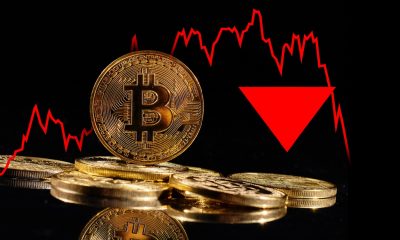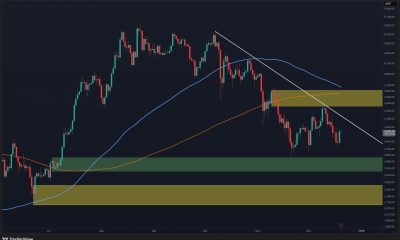

others
Gold remains confined in a range around $2,360, bullish potential seems intact – Crypto News
- Gold price consolidates the previous day’s strong move up to a two-week high.
- Bets for a September rate cut by the Fed continue to lend support to the XAU/USD.
- The overnight rise in the US bond yields underpins the USD and caps the upside.
Gold price (XAU/USD) remains confined in a range during the Asian session on Friday and consolidates the previous day’s strong move up to a two-week high, around the $2,360-2,365 area. The US Treasury bond yields look to build on Thursday’s strong move up in anticipation of new supply next week, which, in turn, is seen as a key factor acting as a headwind for the commodity. That said, Thursday’s softer US data reaffirmed expectations for an imminent start of the Federal Reserve’s (Fed) rate-cutting cycle later this year. This fails to assist the US Dollar (USD) in attracting any follow-through buyers and should act as a tailwind for the non-yielding yellow metal.
Meanwhile, the Bank of England’s (BoE) dovish outlook on Thursday lifted bets for an interest rate cut in August. Furthermore, the European Central Bank (ECB) earlier this month decided to lower borrowing costs and the Swiss National Bank (SNB) also delivered its second rate cut of 2024 on Thursday. This, along with a sustained breakout through the 50-day Simple Moving Average (SMA) on Thursday, favors bullish traders and suggests that the path of least resistance for the Gold price is to the upside. Hence, any corrective slide might be seen as a buying opportunity and is more likely to remain limited as traders look to the flash global PMIs for a fresh impetus.
Daily Digest Market Movers: Gold price remains supported by September Fed rate cut bets
- Disappointing US economic data released on Thursday reinforced market expectations that the Federal Reserve will start its easing program soon and lifted the Gold price to a two-week high.
- The US Department of Labor (DoL) reported that the number of Americans applying for unemployment insurance fell to 238K in the week ending June 15 compared to the 235K expected.
- Moreover, the Commerce Department’s Census Bureau said Housing Starts declined 5.2% to a seasonally adjusted annual rate of 982K units in May, and Building Permits fell 2.9% to 949K units.
- Adding to this, the Philadelphia Fed Manufacturing Index unexpectedly declined to 1.3 in June from 4.5 in the previous month, though it remained in positive territory for a fifth successive month.
- This comes on top of tepid US Retail Sales figures for May and signs of easing inflation, which keeps a September rate cut on the table and should lend support to the non-yielding yellow metal.
- The markets are also pricing in the possibility of another interest rate cut at the December policy meeting despite the Fed policymakers’ hawkish outlook, indicating only one rate cut this year.
- Minneapolis Fed President Neel Kashkari argued that the US economy has proven to be remarkably resilient and that it will probably take a year or two to get inflation back to the 2% target.
- Richmond Fed President Tom Barkin noted that the US central bank has sufficient firepower to address policy issues, but it will have to maintain a strict data-dependent approach.
- The US Treasury bond yields shook off softer US data and rose on Thursday in anticipation of new supply next week, pushing the US Dollar to the weekly top and capping gains for the XAU/USD.
- Investors now look forward to the release of flash PMI prints for cues about the health of the global economy, which should provide some impetus ahead of the US Existing Home Sales data.
Technical Analysis: Gold price could appreciate further while above the 50-day SMA breakpoint
From a technical perspective, the overnight sustained close above the 50-day SMA could be seen as a fresh trigger for bullish traders. This, along with the fact that oscillators on the daily chart have again started gaining positive traction, supports prospects for a further appreciating move. Hence, a subsequent move towards testing the next relevant hurdle, near the $2,378-2380 region, looks like a distinct possibility. The Gold price could eventually aim to reclaim the $2,400 round-figure mark.
On the flip side, the 50-day SMA, currently pegged near the $2,345-2,344 area, now seems to protect the immediate downside ahead of the $2,336-2,335 region. A convincing break below the latter might expose the $2,300 round figure and the $2,285 horizontal support. Some follow-through selling will set the stage for the resumption of the recent retracement slide from the all-time peak touched in May and drag the Gold price further towards the $2,254-2,253 zone.
Fed FAQs
Monetary policy in the US is shaped by the Federal Reserve (Fed). The Fed has two mandates: to achieve price stability and foster full employment. Its primary tool to achieve these goals is by adjusting interest rates. When prices are rising too quickly and inflation is above the Fed’s 2% target, it raises interest rates, increasing borrowing costs throughout the economy. This results in a stronger US Dollar (USD) as it makes the US a more attractive place for international investors to park their money. When inflation falls below 2% or the Unemployment Rate is too high, the Fed may lower interest rates to encourage borrowing, which weighs on the Greenback.
The Federal Reserve (Fed) holds eight policy meetings a year, where the Federal Open Market Committee (FOMC) assesses economic conditions and makes monetary policy decisions. The FOMC is attended by twelve Fed officials – the seven members of the Board of Governors, the president of the Federal Reserve Bank of New York, and four of the remaining eleven regional Reserve Bank presidents, who serve one-year terms on a rotating basis.
In extreme situations, the Federal Reserve may resort to a policy named Quantitative Easing (QE). QE is the process by which the Fed substantially increases the flow of credit in a stuck financial system. It is a non-standard policy measure used during crises or when inflation is extremely low. It was the Fed’s weapon of choice during the Great Financial Crisis in 2008. It involves the Fed printing more Dollars and using them to buy high grade bonds from financial institutions. QE usually weakens the US Dollar.
Quantitative tightening (QT) is the reverse process of QE, whereby the Federal Reserve stops buying bonds from financial institutions and does not reinvest the principal from the bonds it holds maturing, to purchase new bonds. It is usually positive for the value of the US Dollar.
-
others1 week ago
Japan Foreign Investment in Japan Stocks up to ¥528.3B in December 12 from previous ¥96.8B – Crypto News
-

 Technology1 week ago
Technology1 week agoOnePlus 15R vs Pixel 9a: Which phone is the best buy under ₹50,000? Display, camera, processor and more compared – Crypto News
-

 Blockchain6 days ago
Blockchain6 days agoThis Week in Stablecoins: Winning the Back Office – Crypto News
-

 Technology5 days ago
Technology5 days agoApple iPhone 16 price drops to ₹40,990 in Croma’s Cromtastic December Sale: How the deal works – Crypto News
-

 Technology5 days ago
Technology5 days agoApple iPhone 16 price drops to ₹40,990 in Croma’s Cromtastic December Sale: How the deal works – Crypto News
-
Business5 days ago
XRP Holders Eye ‘Institutional Grade Yield’ as Ripple Engineer Details Upcoming XRPL Lending Protocol – Crypto News
-

 Technology5 days ago
Technology5 days agoApple iPhone 16 price drops to ₹40,990 in Croma’s Cromtastic December Sale: How the deal works – Crypto News
-

 others7 days ago
others7 days agoAustralian Dollar loses as US Dollar advances before Michigan Sentiment Index – Crypto News
-
Business6 days ago
DOGEBALL Presale: A Boost to Bring P2E Games Back into the Spotlight – Crypto News
-
others5 days ago
XRP Holders Eye ‘Institutional Grade Yield’ as Ripple Engineer Details Upcoming XRPL Lending Protocol – Crypto News
-

 Blockchain5 days ago
Blockchain5 days agoLitecoin Follows Bitcoin’s Momentum, But Resistance Looms At $79.60 – Crypto News
-

 Technology5 days ago
Technology5 days agoApple iPhone 15 price drops to ₹36,490 in Croma Cromtastic December Sale: How the deal works – Crypto News
-

 Cryptocurrency1 week ago
Cryptocurrency1 week agoCapital gets selective – Blockworks – Crypto News
-
others1 week ago
Low-Fee vs. High-Leverage – How to Choose the Optimal Exchange for Your Trading Strategy? – Crypto News
-

 Blockchain1 week ago
Blockchain1 week agoBlockchain’s Institutional Future Is Private and Permissioned – Crypto News
-
Business6 days ago
125 Crypto Firms Mount Unified Defense as Banks Push to Block Stablecoin Rewards – Crypto News
-
Technology5 days ago
Michael Saylor Sparks Debate Over Bitcoin’s Quantum Risk as Bitcoiners Dismiss It as ‘FUD’ – Crypto News
-

 Technology1 week ago
Technology1 week agoUS Puts Tech Deal With UK on Hold – Crypto News
-

 Blockchain1 week ago
Blockchain1 week agoCiti Says Identity Is the New Gatekeeper for Financial Blockchains – Crypto News
-

 others1 week ago
others1 week agoJapanese Yen strengthens as BoJ rate hike speculation grows – Crypto News
-
Metaverse1 week ago
How companies are using AI to squeeze more from your wallet – Crypto News
-

 Blockchain1 week ago
Blockchain1 week agoBitcoin on Track For 4th Annual Decline Despite Crypto Adoption – Crypto News
-

 Cryptocurrency1 week ago
Cryptocurrency1 week agoWhy quantum computing is becoming a real concern for Bitcoin – Crypto News
-

 Blockchain6 days ago
Blockchain6 days agoCoinbase Launches Service to Help Businesses Create Tokens – Crypto News
-
Business5 days ago
Ethereum Faces Selling Pressure as BitMEX Co-Founder Rotates $2M Into DeFi Tokens – Crypto News
-

 Cryptocurrency5 days ago
Cryptocurrency5 days agoIs ETH Ready for Sustained Recovery or Another Rejection Looms? – Crypto News
-

 Cryptocurrency5 days ago
Cryptocurrency5 days agoXRP Could Add Zero If Rally Is Short-Lived – Crypto News
-

 Blockchain5 days ago
Blockchain5 days agoCrypto Market Sentiment Not Fearful Enough For Bottom: Santiment – Crypto News
-

 Blockchain5 days ago
Blockchain5 days agoCrypto Market Sentiment Not Fearful Enough For Bottom: Santiment – Crypto News
-

 Blockchain5 days ago
Blockchain5 days agoLitecoin Follows Bitcoin’s Momentum, But Resistance Looms At $79.60 – Crypto News
-

 Technology4 days ago
Technology4 days agoSamsung Galaxy S25 Ultra price drops to ₹69,999 at Croma Cromtastic December Sale? Here’s how the deal works – Crypto News
-

 Blockchain1 week ago
Blockchain1 week agoHow Blockchain Works – Crypto News
-

 Metaverse1 week ago
Metaverse1 week agoSpaceX has two aces up its sleeve in the battle to put AI data centers in space – Crypto News
-

 Cryptocurrency1 week ago
Cryptocurrency1 week agoBitcoin and Ethereum Wobble as US Reports Highest Unemployment Rate Since 2021 – Crypto News
-

 others1 week ago
others1 week agoSEC Crypto Roundtable Questions Whether Americans Can Transact Without Surrendering Privacy – Crypto News
-

 Blockchain7 days ago
Blockchain7 days agoMastercard, BlackRock Join Middle East-Focused Blockchain Effort – Crypto News
-

 Technology7 days ago
Technology7 days agoFrom chibi to plushie: 7 Must-try AI portraits you can create with GPT Image 1.5 – Crypto News
-

 Technology7 days ago
Technology7 days agoFrom chibi to plushie: 7 Must-try AI portraits you can create with GPT Image 1.5 – Crypto News
-
Business7 days ago
Breaking: VanEck Discloses Fees and Staking Details for its Avalanche ETF – Crypto News
-

 Cryptocurrency6 days ago
Cryptocurrency6 days agoBTC at $143K, ETH above $4000: Citi issues bullish price forecasts as crypto market continues to struggle – Crypto News
-
Business6 days ago
Bitcoin Price Alarming Pattern Points to a Dip to $80k as $2.7b Options Expires Today – Crypto News
-

 Metaverse6 days ago
Metaverse6 days agoAI Tool of the Week: Transform marketing concepts instantly. – Crypto News
-

 Blockchain6 days ago
Blockchain6 days agoBlackRock’s IBIT Ranks 6th in ETF Flows Despite Negative Returns – Crypto News
-

 others5 days ago
others5 days agoElliott Wave, seasonality, and cycles indicate more upside – Crypto News
-

 others5 days ago
others5 days agoElliott Wave, seasonality, and cycles indicate more upside – Crypto News
-

 Cryptocurrency5 days ago
Cryptocurrency5 days agoCrypto Industry Must Make Progress Before Trump Leaves Office: Etherealize Co-Founder – Crypto News
-

 Cryptocurrency5 days ago
Cryptocurrency5 days agoCrypto Industry Must Make Progress Before Trump Leaves Office: Etherealize Co-Founder – Crypto News
-

 Blockchain5 days ago
Blockchain5 days agoBlockchain and AI Vibe-Coding To Dethrone Amazon Web Servies: Crypto exec – Crypto News
-

 Blockchain5 days ago
Blockchain5 days agoBanks Need XRP To Be Pricier—Here’s Why A Finance Expert Says So – Crypto News
-

 Technology1 week ago
Technology1 week agoOnePlus 15R and OnePlus Pad Go 2 launching in India tomorrow: How to watch live-stream, expected price, specs and more – Crypto News










